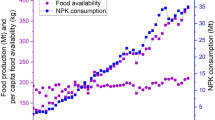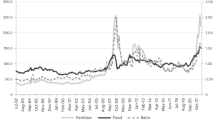Abstract
Nutrient recycling from wastes to agriculture can contribute to food production by closing yield gaps, yet the global amount of poorly utilized nitrogen (N), phosphorus (P) and potassium (K) in excreta at a subnational scale has been insufficiently explored. The global amounts found in human excreta and poorly utilized livestock excreta represent 16% (±7%), 8% (±9%) and 14% (±6%) of crop and grassland N, P and K needs, respectively. National recycling of nutrients in poorly utilized excreta could reduce global net imports of mineral fertilizers by 41% N, 3% P and 36% K. In countries where nutrient supply through locally available livestock excreta and mineral fertilizers do not meet nutrient requirements by crops and grasslands, the recycling of poorly utilized excreta could reduce this difference by, on average, 20% N, 11% P and 13% K, therefore contributing to the move towards a circular economy between food consumption and agriculture.
This is a preview of subscription content, access via your institution
Access options
Access Nature and 54 other Nature Portfolio journals
Get Nature+, our best-value online-access subscription
$32.99 / 30 days
cancel any time
Subscribe to this journal
Receive 12 digital issues and online access to articles
$119.00 per year
only $9.92 per issue
Buy this article
- Purchase on SpringerLink
- Instant access to full article PDF
Prices may be subject to local taxes which are calculated during checkout






Similar content being viewed by others
Data availability
All data used in this manuscript were obtained from publicly available data described in the Methods and calculations are available in the Supplementary Information. Livestock density maps can be found at the Harvard Dataverse repository https://dataverse.harvard.edu/dataverse/glw_3, with the identifiers https://doi.org/10.7910/DVN/GIVQ75, https://doi.org/10.7910/DVN/OCPH42, https://doi.org/10.7910/DVN/33N0JG, https://doi.org/10.7910/DVN/BLWPZN, https://doi.org/10.7910/DVN/SUFASB and https://doi.org/10.7910/DVN/ICHCBH. The national average supply of protein and calories to human population data are available from FAOSTAT database at https://www.fao.org/faostat/en/#data/FS. The GeoTIFF files for crop yield and harvested area were retrieved from https://dataverse.harvard.edu/dataset.xhtml?persistentId=doi:10.7910/DVN/PRFF8V and https://doi.org/10.7910/DVN/PRFF8V. Crop-specific coefficients for biological nitrogen fixation estimation are found at https://www.ifastat.org/nutrient-use-efficiency. Grassland net primary production maps are available at https://lpdaac.usgs.gov/products/mod17a3hv006/, whereas the pasture area GeoTIFF file can be found at http://www.earthstat.org/cropland-pasture-area-2000/ and https://doi.org/10.1029/2007GB002952 and the shapefile mapping the global distribution of grasslands per type is available at https://www.worldwildlife.org/publications/world-grassland-types. The monthly averaged data on air temperature were retrieved from the C3S CDS database at https://doi.org/10.24381/cds.f17050d7. Finally, the data on mineral fertilizer production, imports, exports and use were obtained from the FAOSTAT database at https://www.fao.org/faostat/en/#data/RFN.
Code availability
The R markdown for data analysis and mapping is available from the corresponding author upon reasonable request.
References
Komarek, A. M. et al. Agricultural household effects of fertilizer price changes for smallholder farmers in central Malawi. Agric. Syst. 154, 168–178 (2017).
Smith, L. E. D. & Siciliano, G. A comprehensive review of constraints to improved management of fertilizers in China and mitigation of diffuse water pollution from agriculture. Agric. Ecosyst. Environ. 209, 15–25 (2015).
Roy, E. D. et al. The phosphorus cost of agricultural intensification in the tropics. Nat. Plants 2, 16043 (2016).
Donner, S. The impact of cropland cover on river nutrient levels in the Mississippi River Basin. Glob. Ecol. Biogeogr. 12, 341–355 (2003).
Erisman, J. W., Sutton, M. A., Galloway, J., Klimont, Z. & Winiwarter, W. How a century of ammonia synthesis changed the world. Nat. Geosci. 1, 636–639 (2008).
Manning, D. A. C. How will minerals feed the world in 2050? Proc. Geol. Assoc. 126, 14–17 (2015).
Peñuelas, J. et al. Human-induced nitrogen–phosphorus imbalances alter natural and managed ecosystems across the globe. Nat. Commun. 4, 2934 (2013).
Mueller, N. D. et al. Declining spatial efficiency of global cropland nitrogen allocation. Glob. Biogeochem. Cycles 31, 245–257 (2017).
Lun, F. et al. Global and regional phosphorus budgets in agricultural systems and their implications for phosphorus-use efficiency. Earth Syst. Sci. Data 10, 1–18 (2018).
Dhillon, J. S., Eickhoff, E. M., Mullen, R. W. & Raun, W. R. World potassium use efficiency in cereal crops. Agron. J. 111, 889–896 (2019).
Zhang, X. et al. Managing nitrogen for sustainable development. Nature 528, 51–59 (2015).
Mueller, N. D. et al. Closing yield gaps through nutrient and water management. Nature 490, 254–257 (2012).
Ilea, R. C. Intensive livestock farming: global trends, increased environmental concerns, and ethical solutions. J. Agric. Environ. Ethics 22, 153–167 (2009).
Bai, Z. et al. Nitrogen, phosphorus, and potassium flows through the manure management chain in China. Environ. Sci. Technol. 50, 13409–13418 (2016).
Trimmer, J. T. & Guest, J. S. Recirculation of human-derived nutrients from cities to agriculture across six continents. Nat. Sustain. 1, 427–435 (2018).
Towards the Circular Economy: Economic and Business Rationale for an Accelerated Transition (The Ellen MacArthur Foundation, 2013).
Morée, A. L., Beusen, A. H. W., Bouwman, A. F. & Willems, W. J. Exploring global nitrogen and phosphorus flows in urban wastes during the twentieth century: twentieth century urban N and P flows. Glob. Biogeochem. Cycles 27, 836–846 (2013).
Kelova, M. E., Eich-Greatorex, S. & Krogstad, T. Human excreta as a resource in agriculture—evaluating the fertilizer potential of different composting and fermentation-derived products. Resour. Conserv. Recycl. 175, 105748 (2021).
Water in a Changing World (Earthscan, 2009).
Sichler, T. C., Adam, C., Montag, D. & Barjenbruch, M. Future nutrient recovery from sewage sludge regarding three different scenarios—German case study. J. Clean. Prod. 333, 130130 (2022).
Harvey, F. Nearly 30,000 tonnes of sewage sludge containing human waste to enter UK. The Guardian www.theguardian.com/environment/2020/sep/02/sewage-sludge-containing-human-waste-uk (2020).
Cucina, M., De Nisi, P., Sordi, S. & Adani, F. Sewage sludge as N-fertilizers for crop production enabling the circular bioeconomy in agriculture: a challenge for the new EU regulation 1009/2019. Sustainability 13, 13165 (2021).
Milojevic, N. & Cydzik-Kwiatkowska, A. Agricultural use of sewage sludge as a threat of microplastic (MP) spread in the environment and the role of governance. Energies 14, 6293 (2021).
Paudel, K. P., Bhattarai, K., Gauthier, W. M. & Hall, L. M. Geographic information systems (GIS) based model of dairy manure transportation and application with environmental quality consideration. Waste Manag. 29, 1634–1643 (2009).
Nolan, T. et al. Economic analyses of pig manure treatment options in Ireland. Bioresour. Technol. 105, 15–23 (2012).
Schnorf, V., Trutnevyte, E., Bowman, G. & Burg, V. Biomass transport for energy: cost, energy and CO2 performance of forest wood and manure transport chains in Switzerland. J. Clean. Prod. 293, 125971 (2021).
Oenema, O., Oudendag, D. & Velthof, G. L. Nutrient losses from manure management in the European Union. Livest. Sci. 112, 261–272 (2007).
van Es, H. M., Sogbedji, J. M. & Schindelbeck, R. R. Effect of manure application timing, crop, and soil type on nitrate leaching. J. Environ. Qual. 35, 670–679 (2006).
Schröder, J. J., Jansen, A. G. & Hilhorst, G. J. Long-term nitrogen supply from cattle slurry. Soil Use Manag. 21, 196–204 (2005).
Boessen, C. & Massey R. Securing Manure Spreading Rights Through Easements (Univ. Missouri-Columbia, 2018).
Lassaletta, L. et al. Food and feed trade as a driver in the global nitrogen cycle: 50-year trends. Biogeochemistry 118, 225–241 (2014).
Oita, A. et al. Substantial nitrogen pollution embedded in international trade. Nat. Geosci. 9, 111–115 (2016).
Kanter, D. R. et al. Nitrogen pollution policy beyond the farm. Nat. Food 1, 27–32 (2020).
Bai, Z. H. et al. Changes in pig production in China and their effects on nitrogen and phosphorus use and losses. Environ. Sci. Technol. 48, 12742–12749 (2014).
Uwizeye, A. et al. Nitrogen emissions along global livestock supply chains. Nat. Food 1, 437–446 (2020).
Liu, J. et al. A review of regulations and guidelines related to winter manure application. Ambio 47, 657–670 (2018).
Kuhn, T., Schäfer, D., Holm-Müller, K. & Britz, W. On-farm compliance costs with the EU-nitrates directive: a modelling approach for specialized livestock production in northwest Germany. Agric. Syst. 173, 233–243 (2019).
Zhang, C. et al. Rebuilding the linkage between livestock and cropland to mitigate agricultural pollution in China. Resour. Conserv. Recycl. 144, 65–73 (2019).
Jin, S. et al. Decoupling livestock and crop production at the household level in China. Nat. Sustain. 4, 48–55 (2020).
Progress on Drinking Water, Sanitation and Hygiene: 2017 Update and SDG Baselines (WHO, 2017).
Sustainable Development Goals—Goal 6: Clean Water and Sanitation. United Nations www.sdgfund.org/goal-6-clean-water-and-sanitation (2020).
Leigland, J., Trémolet, S. & Ikeda, J. Achieving Universal Access to Water and Sanitation by 2030: The Role of Blended Finance (World Bank, 2016).
Auerbach, D. in Broken Pumps and Promises (ed. Thomas, E.) 211–216 (Springer, 2016).
Making Blended Finance Work for Water and Sanitation: Unlocking Commercial Finance for SDG 6 (OECD Publishing, 2019).
Rose, C., Parker, A., Jefferson, B. & Cartmell, E. The characterization of feces and urine: a review of the literature to inform advanced treatment technology. Crit. Rev. Environ. Sci. Technol. 45, 1827–1879 (2015).
McConville, J. R., Metson, G. S. & Persson, H. Acceptance of human excreta derived fertilizers in Swedish grocery stores. City Environ. Interact. 17, 100096 (2023).
Akram, U., Quttineh, N.-H., Wennergren, U., Tonderski, K. & Metson, G. S. Optimizing nutrient recycling from excreta in Sweden and Pakistan: higher spatial resolution makes transportation more attractive. Front. Sustain. Food Syst. 3, 50 (2019).
Gilbert, M. et al. Income disparities and the global distribution of intensively farmed chicken and pigs. PLoS ONE 10, e0133381 (2015).
Chadwick, D. et al. Improving manure nutrient management towards sustainable agricultural intensification in China. Agric. Ecosyst. Environ. 209, 34–46 (2015).
Bora, R. R. et al. Techno-economic feasibility and spatial analysis of thermochemical conversion pathways for regional poultry waste valorization. ACS Sustain. Chem. Eng. 8, 5763–5775 (2020).
Harder, R., Wielemaker, R., Larsen, T. A., Zeeman, G. & Öberg, G. Recycling nutrients contained in human excreta to agriculture: pathways, processes, and products. Crit. Rev. Environ. Sci. Technol. 49, 695–743 (2019).
Moya, B., Parker, A. & Sakrabani, R. Challenges to the use of fertilisers derived from human excreta: the case of vegetable exports from Kenya to Europe and influence of certification systems. Food Policy 85, 72–78 (2019).
Andersson, M. & Minoia, P. Ecological sanitation: a sustainable goal with local choices. A case study from Taita Hills, Kenya. Afr. Geogr. Rev. 36, 183–199 (2017).
Ito, R., Takahashi, E. & Funamizu, N. Production of slow-released nitrogen fertilizer from urine. Environ. Technol. 34, 2809–2815 (2013).
Billen, P., Costa, J., Van der Aa, L., Van Caneghem, J. & Vandecasteele, C. Electricity from poultry manure: a cleaner alternative to direct land application. J. Clean. Prod. 96, 467–475 (2015).
Trimmer, J. T., Cusick, R. D. & Guest, J. S. Amplifying progress toward multiple development goals through resource recovery from sanitation. Environ. Sci. Technol. 51, 10765–10776 (2017).
Ohm, T.-I., Chae, J.-S., Moon, S.-H. & Jung, B.-J. Experimental study of the characteristics of solid fuel from fry-dried swine excreta. Process Saf. Environ. Prot. 91, 227–234 (2013).
Simons, A., Solomon, D., Chibssa, W., Blalock, G. & Lehmann, J. Filling the phosphorus fertilizer gap in developing countries. Nat. Geosci. 7, 3–3 (2014).
R Core Team. R: A Language and Environment for Statistical Computing (R Foundation for Statistical Computing, 2023).
Gilbert, M. et al. Global distribution data for cattle, buffaloes, horses, sheep, goats, pigs, chickens and ducks in 2010. Sci. Data 5, 180227 (2018).
Smil, V. Nitrogen and food production: proteins for human diets. Ambio 31, 126–131 (2002).
Mihelcic, J. R., Fry, L. M. & Shaw, R. Global potential of phosphorus recovery from human urine and feces. Chemosphere 84, 832–839 (2011).
Jönsson, H., Stintzing, A. R., Vinneras, B. & Salomon, E. Guidelines on the Use of Urine and Faeces in Crop Production (Stockholm Environment Institute, 2004).
Holbrook, J. T. et al. Sodium and potassium intake and balance in adults consuming self-selected diets. Am. J. Clin. Nutr. 40, 786–793 (1984).
Gridded Population of the World, Version 4 (GPWv4): Population Density, Revision 11. (Earth Data, accessed 18 August 2022); https://doi.org/10.7927/H49C6VHW
IFPRI. Global spatially-disaggregated crop production statistics data for 2010 version 2.0. Harvard Dataverse https://doi.org/10.7910/DVN/PRFF8V (2019).
Wichmann, W. IFA World Fertilizer Use Manual (IFA, 1992).
Ramankutty, N., Evan, A. T., Monfreda, C. & Foley, J. A. Farming the planet: 1. Geographic distribution of global agricultural lands in the year 2000. Glob. Biogeochem. Cycles 22, GB1003 (2008).
Dixon, A. P., Faber-Langendoen, D., Josse, C., Morrison, J. & Loucks, C. J. Distribution mapping of world grassland types. J. Biogeogr. 41, 2003–2019 (2014).
De Leeuw, J. et al. Application of the MODIS MOD 17 net primary production product in grassland carrying capacity assessment. Int. J. Appl. Earth Obs. Geoinf. 78, 66–76 (2019).
ERA5 Monthly Averaged Data on Single Levels from 1979 to Present. C3S https://doi.org/10.24381/CDS.F17050D7 (2019).
2006 IPCC Guidelines for National Greenhouse Gas Inventories (Institute for Global Environmental Strategies, 2006).
2019 Refinement to the 2006 IPCC Guidelines for National Greenhouse Gas Inventories. IPCC www.ipcc-nggip.iges.or.jp/public/2019rf/vol4.html (2019).
Baston, D. exactextractr: Fast extraction from raster datasets using polygons. R package version 0.10.0. CRAN https://doi.org/10.32614/CRAN.package.exactextractr (2023).
Ku, H. H. Notes on the use of propagation of error formulas. J. Res. Natl Bur. Stan. C 70C, 263 (1966).
Scoones, I. Livestock, methane, and climate change: the politics of global assessments. WIREs Clim. Change 14, e790 (2023).
Tiscornia, G., Jaurena, M. & Baethgen, W. Drivers, process, and consequences of native grassland degradation: insights from a literature review and a survey in Río de la Plata grasslands. Agronomy 9, 239 (2019).
Lammerts Van Bueren, E. T. & Struik, P. C. Diverse concepts of breeding for nitrogen use efficiency: a review. Agron. Sustain. Dev. 37, 50 (2017).
Wang, F. & Peng, S. Yield potential and nitrogen use efficiency of China’s super rice. J. Integr. Agric. 16, 1000–1008 (2017).
Acknowledgements
M.D. acknowledges financial support from Centre Mondial de l’Innovation Roullier under the fellowship agreement number OSP 90583.
Author information
Authors and Affiliations
Contributions
M.D., J.L. and D.W. conceptualized and designed the study. M.D. collected the data and prepared the online supporting material. With help from D.W., M.D. led the data processing and analysis. M.D. and J.L. prepared the first draft of the paper. M.D., J.L. and D.W. contributed to writing the paper.
Corresponding author
Ethics declarations
Competing interests
M.D. was employed by Groupe Roullier. The other authors declare no competing interests.
Peer review
Peer review information
Nature Sustainability thanks Thomas Nesme and the other, anonymous, reviewer(s) for their contribution to the peer review of this work.
Additional information
Publisher’s note Springer Nature remains neutral with regard to jurisdictional claims in published maps and institutional affiliations.
Supplementary information
Supplementary Information
Sensitivity analysis, references and Supplementary Figs. 1–7.
Supplementary Tables
Supplementary Tables 1–10.
Rights and permissions
Springer Nature or its licensor (e.g. a society or other partner) holds exclusive rights to this article under a publishing agreement with the author(s) or other rightsholder(s); author self-archiving of the accepted manuscript version of this article is solely governed by the terms of such publishing agreement and applicable law.
About this article
Cite this article
Devault, M., Woolf, D. & Lehmann, J. Nutrient recycling potential of excreta for global crop and grassland production. Nat Sustain 8, 99–111 (2025). https://doi.org/10.1038/s41893-024-01467-8
Received:
Accepted:
Published:
Issue date:
DOI: https://doi.org/10.1038/s41893-024-01467-8
This article is cited by
-
Managing for climate and production goals on crop-lands
Nature Climate Change (2025)
-
Synergistic biochar-silicon amendments: a mechanistic study to enhanced salt tolerance and soil health in turfgrass systems
Plant and Soil (2025)



